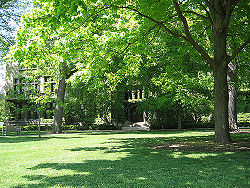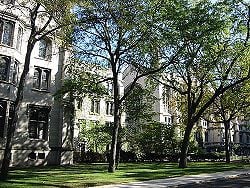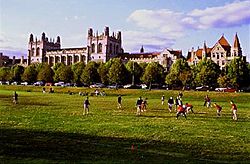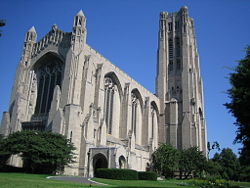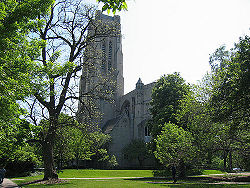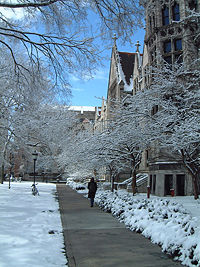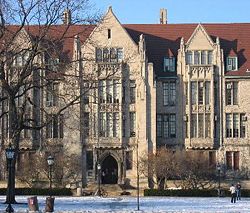University of Chicago
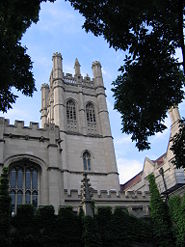
| |
| Motto | Crescat scientia; vita excolatur (Latin for "Let knowledge grow from more to more; and so be human life enriched.")[1] |
|---|---|
| Established | 1890 by John D. Rockefeller |
| Type | Private nondenominational coeducational |
| Location | |
| Website | www.uchicago.edu |
The University of Chicago is a private university located principally in the Hyde Park neighborhood of Chicago. Founded in 1890 by the oil magnate John D. Rockefeller, the University of Chicago held its first classes on October 1, 1892. Chicago was one of the first universities in the country to be conceived as a combination of the American interdisciplinary liberal arts college and the German research university. It was the first major university to enroll women on an equal basis with men, and has always held a non-sectarian perspective.
Following the German precedent of a research university, the University of Chicago revolved around a number of graduate research institutions. It has, indeed, been remarkably successful in its research endeavors. Affiliated with over 80 Nobel Prize laureates, the University of Chicago is widely regarded as one of the world's foremost universities. As a result, the number of graduate students greatly outnumbers that of undergraduates. Historically, the university is noted for the unique undergraduate core curriculum pioneered by Robert Maynard Hutchins in the 1930s, and for influential academic movements such as the Chicago School of Economics, the Chicago School of Sociology, the Chicago School of Literary Criticism, and the law and economics movement in legal analysis. The University of Chicago was the site of the world's first man-made self-sustaining nuclear reaction. It is also home to the largest university press in the United States. The university continues to strive for excellence in research, contributing in numerous was to the advancement of knowledge about the world.
Mission and reputation
Oil magnate and philanthropist John D. Rockefeller founded the school in 1890. Westward migration, population growth, and industrialization led to an increasing need for elite schools away from the East Coast, especially schools that would focus on issues vital to national development. Though Rockefeller was urged to build in New England or the Mid-Atlantic region of the United States, he ultimately chose Chicago. His choice reflected his strong desire to realize Thomas Jefferson's dream of a natural meritocracy's rise to prominence, determined by talent rather than familial heritage. Rockefeller's early fiscal emphasis on the physics department showed his pragmatic, yet deeply intellectual, desires for the school.
Though founded under Baptist auspices, the University of Chicago has never had a sectarian affiliation. The school's traditions of rigorous scholarship were established primarily by Presidents William Rainey Harper and Robert Maynard Hutchins. Chicago opened its door to women and minorities from the very beginning, a time when they seldom had access to other leading universities. It was the first major university to enroll women on an equal basis with men,[2] as well as the first major, predominantly white university to offer a black professor a tenured position, in 1947.[3]
The university has also been an incubator for several prominent business ventures, with the world’s first management consultancy, McKinsey & Company[4], software giant Oracle, and the United States first international corporate law firm, Baker and McKenzie[5], all having been founded by University of Chicagoans.
History
Founding
The University of Chicago was founded by the American Baptist Education Society and oil magnate John D. Rockefeller, who later called it "the best investment I ever made."[6] The University's founding was part of a wave of university foundings that followed the American Civil War. Incorporated in 1890, the University has dated its founding as July 1, 1891, when William Rainey Harper became its first president. The first classes were held on October 1, 1892, with an enrollment of 594 students and a faculty of 120, including eight former college presidents.[7]
Unlike many other American universities at the time (with the notable exception of Johns Hopkins University), the University of Chicago revolved around a number of graduate research institutions, following Germanic precedent. The College of the University of Chicago remained quite small compared to its East Coast peers until around the middle of the twentieth century.
As a result, the graduate population of the university dwarfs the undergraduate population 2:1 to this day, while the university's undergraduate student body remains the third smallest amongst the top 10 national universities. The student-to-faculty ratio is 4:1, one of the lowest amongst national universities, and all faculty members are required to teach undergraduate courses.[8][9]
Twentieth century
During his presidency, Robert Maynard Hutchins met with the president of rival Northwestern University to discuss the future of the two institutions through the Depression and the looming war. Hutchins concluded that, in order to secure the future of both universities, it was in the best interest of both for the two campuses to merge as the "Universities of Chicago," with Northwestern's campus serving as the site for undergraduate education and the Hyde Park campus serving as the graduate studies campus. President Hutchins' vision for what he hoped would become the preeminent university in the world was eventually undermined by Northwestern University's board of trustees, a result that Hutchins called "one of the lost opportunities of American education."[10]
Starting in the 1930s, the university conducted a more successful experiment on the college. To make the university a preeminent undergraduate academic institution, administrators decided to implement President Hutchins' philosophy of Secular Perennialism. This led to the innovation of the common core, an educational strategy in which students read original source materials rather than textbooks, and discuss them in small groups using the Socratic method rather than a lecture approach. The common core is still an important feature of Chicago's undergraduate education. In addition to pioneering this new undergraduate curriculum, the university took steps to eliminate "distractions" such as varsity sports, fraternities and religious organizations. This attracted free-thinkers such as Carl Sagan and Kurt Vonnegut to the university. The university succeeded in eliminating all varsity sports for 20 years and all but four fraternities.
In addition to its contributions to higher education, the University of Chicago made significant contributions to twentieth century science. In 1909 Professor Robert Millikan performed the historic oil-drop experiment in the Ryerson Physical Laboratory on the university campus.[11] This experiment allowed Millikan to calculate the charge of an electron and paved the way for quantum mechanics in the 1940s. The American Physical Society now designates Ryerson Laboratory an historic physics site.[12]
As part of the Manhattan Project, University of Chicago chemists, led by Glenn T. Seaborg, began to study the newly manufactured radioactive element plutonium. The George Herbert Jones Laboratory was the site where, for the first time, a trace quantity of this new element was isolated and measured in September 1942. This procedure enabled chemists to determine the new element's atomic weight. Room 405 of the building was named a National Historic Landmark in May 1967.[13]
On December 2, 1942, scientists achieved the world's first self-sustained nuclear reaction at Stagg Field on the campus of the university under the direction of professor Enrico Fermi. A sculpture by Henry Moore marks the spot, now deemed a National Historic Landmark, where the nuclear reaction took place. Stagg Field has since been demolished to make way for the Regenstein Library.
In addition to its groundbreaking work in physics, the University of Chicago is recognized for numerous other important scientific discoveries[14] These include
- The technique of carbon-14 dating, developed in 1949 by Willard Frank Libby and his team during his tenure as a professor at the university. Libby was awarded the Nobel Prize in Chemistry in 1960 for this discovery.
- The discovery of the atmosphere's jet stream.
- The discovery of REM sleep.
- The procedure for the nation's first living-donor liver transplant.[9]
- The famous Miller-Urey experiment, considered to be the classic experiment on the origin of life.
- The development of agent orange, a highly-toxic herbicide that would gain notoriety for its use during the Vietnam War.[15]
In 1955, the University of Chicago became the birthplace of improvisational comedy with the formation of the undergraduate comedy troupe, the Compass Players.[16]
In 1959, the university’s literary journal the Chicago Review, under editors Irving Rosenthal and Paul Carroll, first published excerpts from William S. Burroughs’ experimental novel Naked Lunch. The material appeared in the Spring 1958 edition. The university was criticized for publishing fiction deemed obscene by a columnist in the Chicago Daily News and suppressed the Winter 1959 issue, which contained more material from the Naked Lunch manuscript. The university administration fired Rosenthal and Carroll, who regarded the university's attempt at suppressing Naked Lunch as censorship.[17]
In 1978, Hanna Holborn Gray, then the provost of Yale University, became President of the University of Chicago, the first woman ever to serve as the president of a major research university.
In 1990, the Consortium on Chicago School Research (CCSR) was created after the passage of the Chicago School Reform Act that decentralized governance of the city's public schools. Researchers at the University of Chicago joined with researchers from Chicago Public Schools and other organizations to form CCSR with the imperative to study this landmark restructuring and its long-term effects. Since then CCSR has undertaken research on many of Chicago's school reform efforts, some of which have been embraced by other cities as well. Thus, CCSR studies have also informed broader national movements in public education.
In 1999, then-President Hugo Sonnenschein announced plans to relax the university's famed core curriculum, reducing the number of required courses from 21 to 15. When The New York Times, The Economist, and other major news outlets picked up this story, the university became the focal point of a national debate on education. The National Association of Scholars, for example, released a statement saying, "It is truly depressing to observe a steady abandonment of the University of Chicago's once imposing undergraduate core curriculum, which for so long stood as the benchmark of content and rigor among American academic institutions."[18] The changes were ultimately implemented, but the controversy led to Sonnenschein's resignation in 2000.
Twenty-first century
In 2006, the University of Chicago's Oriental Institute became the center of controversy when U.S. federal courts ruled to seize and auction its valuable collection of ancient Persian artifacts, the proceeds of which would go to compensate the victims of a 1997 bombing in Jerusalem that the United States claims was funded by Iran. The ruling threatens the university's invaluable collection of ancient clay tablets held by the Oriental Institute since the 1930s but officially owned by Iran.
In 2007, the University of Chicago received an anonymous alumni donation of $100 million. The donation serves as the cornerstone of a $400 million undergraduate student aid initiative for enhanced financial aid packages called Odyssey Scholarships, which will eliminate student loans entirely among students whose annual family income is less than $60,000 and will eliminate half the student loan packages among students whose annual family income is between $60,000 and $75,000. The College expects nearly a quarter of the entire College population to benefit from the program.[19]
Facilities
The University of Chicago is principally located seven miles (11 km) south of downtown Chicago, in the Hyde Park and Woodlawn neighborhoods. The campus is bisected by Frederick Law Olmsted's Midway Plaisance, a large linear park created for the 1893 World's Fair. While the bulk of the campus is located north of the Midway, some of the professional schools are located south of the Midway. The quadrangles of the main campus feature a botanical garden and neo-Gothic buildings constructed mostly out of limestone in the late nineteenth century. The tallest building is Rockefeller Chapel, designed by Bertram Goodhue. Buildings of the original quadrangles were deliberately patterned after the layouts of Oxford University and Cambridge University. Mitchell Tower, for example, is a smaller-sized reproduction of Oxford's Magdalen Tower,[20] and the University Commons, Hutchinson Hall, is a duplicate of Oxford's Christ Church Hall.[21]
Contemporary buildings have attempted to complement the style of the original architecture. Notable examples include the Laird Bell Law Quadrangle by Eero Saarinen, the School of Social Service Administration by Ludwig Mies van der Rohe, and the Robie House by Frank Lloyd Wright. The largest modern addition is the Regenstein Library, designed by architect Walter Netsch and constructed on the grounds of the former Stagg Field, the site of the world's first nuclear reaction.
The University of Chicago also maintains a number of facilities apart from its main campus. The university's Graduate School of Business maintains campuses in Singapore, London and in downtown Chicago, while the Paris Center, a campus located on the left bank of the River Seine in Paris, hosts various undergraduate and graduate study programs.
The university's Yerkes Observatory, constructed in 1897 and located in Williams Bay, Wisconsin, is home to the largest refracting telescope ever built.[22] Although Yerkes was never able to match the observation conditions afforded by the mountaintop location of its main competitor, the Lick Observatory, the telescope was a leader in astrophysics. Yerkes was the first telescope to determine the spiral structure of the Milky Way Galaxy and the first to observe carbon in stellar spectra.
The University of Chicago campus is also home to the Oriental Institute, an internationally renowned archeology museum and research center for ancient Near Eastern studies. The Institute is housed in an unusual Gothic and Art Deco building designed by the architectural firm Mayers Murray & Phillip. The Museum has artifacts from digs in Egypt, Israel, Syria, Turkey, Iraq, and Iran. Notable possessions include the famous Megiddo Ivories, various treasures from Persepolis, the old Persian capital, a 40-ton human-headed winged lamassu from Khorsabad, the capital of Sargon II, and a monumental statue of King Tutankhamun.
Academics
The University of Chicago's economics department is particularly well-known. In fact, an entire school of thought (the Chicago School of Economics) bears its name. Led by Nobel Prize laureates such as Milton Friedman, Ronald Coase, George Stigler, Gary Becker, Robert Lucas, James Heckman, and Robert Fogel, the university's economics department has played an important role in shaping ideas about the free market. The Chicago School of Economics is also famous for applying economic principles to every aspect of human life, as famously demonstrated by University of Chicago Professor Steven Levitt in his best-selling book, Freakonomics.
The university is also known for creating the first sociology department in the United States, which later gave birth to the Chicago School of Sociology. Scholars affiliated with this school are considered pioneers in the field and include Albion Small, George Herbert Mead, Robert E. Park, W. I. Thomas, and Ernest Burgess.[23]
The university is home to several committees for interdisciplinary scholarship, the most famous of which is the Committee on Social Thought. One of several Ph.D-granting committees at the university, it was started in 1941 by University of Chicago president Robert Maynard Hutchins along with historian John U. Nef, economist Frank Knight, and anthropologist Robert Redfield. The committee is interdisciplinary, but it is not centered on any specific topic. Since its inception, the committee has drawn together noted academics and writers to "foster awareness of the permanent questions at the origin of all learned inquiry".[24] Members of this program have included Hannah Arendt, T. S. Eliot, David Grene, Leo Strauss, Allan Bloom, Friedrich von Hayek, Leon Kass, Mark Strand, Wayne Booth, Joseph Rutherford Hicks and J.M. Coetzee.[24]
In 1983, the University of Chicago implemented the University of Chicago School Mathematics Project, a comprehensive mathematics program for students from kindergarten through twelfth grade. Today, an estimated 3.5 to 4 million students in elementary and secondary schools in every state and virtually every major urban area are now using UCSMP materials.[25]
Divisions and schools
The University of Chicago currently maintains 12 units: the College, four divisions of graduate research, six professional schools, and the Graham School of General Studies. The University of Chicago also operates the Library, the Press, the Lab Schools, and the Hospitals.
Faculty and students at the adjacent Toyota Technological Institute at Chicago also collaborate closely with the university.[26] Although formally unrelated, the National Opinion Research Center (NORC) is also located on the campus, and many faculty members and graduate students hold research appointments at NORC.
The university also operates the University of Chicago Laboratory Schools (from day care through high school, founded by John Dewey and considered one of the leading preparatory schools in the United States), the Hyde Park Day Schools (for the learning disabled of otherwise exceptional ability), and the Orthogenic School (a residential treatment program for those with behavioral and emotional problems).[27] The university also administers two unaffiliated public charter schools on the South Side of Chicago.
The University of Chicago Press is the largest university press in the country.[28] It publishes a wide array of scholarly and academic texts, including the influential Chicago Manual of Style, as well as several academic journals, including Critical Inquiry.
The University of Chicago's library system is also one of the largest in the country. The university's Regenstein Library is committed to providing physical, "browsable" access to print books in a single location, rather than relying on offsite storage as many libraries do. In 2005, funding was approved for the construction of a 308,000-square-foot (28,600 m²) addition to the library to accommodate an expansion of its collection. When the expansion is complete, the Regenstein will contain the largest browsable collection of print volumes in the United States.[29] The university expects to finish construction by winter of 2009.[30] The "Reg," as it is commonly called by students, is noted for its exceptional breadth and depth of material. In its 2007 rankings, the Princeton Review ranked it among the top college libraries in the country.[31]
The John Crerar Library is recognized as one of the best libraries in the country for research and teaching in the sciences, medicine, and technology. Completing the science quadrangle is the Kersten Physics Teaching Center, which is recognized as the most advanced facility in the United States for teaching undergraduate physics. Students in the College have access to all of the university’s special libraries, including the D’Angelo Law Library, Yerkes Observatory Library for astronomy and astrophysics, the Social Service Administration Library, and the Eckhart Library for mathematics and computer science.[9]
Chicago also operates a number of off-campus scientific research institutions, including the Argonne National Laboratory, part of the United States Department of Energy's national laboratory system. The university also owns and operates the Oriental Institute and has a stake in the Apache Point Observatory in Sunspot, New Mexico. It is also a founding member of the Committee on Institutional Cooperation.
Undergraduate college
The College of the University of Chicago grants Bachelor of Arts and Bachelor of Science degrees in 52 majors and 14 minors in the biological, physical, and social sciences, as well as in the humanities and interdisciplinary areas. A major may provide a comprehensive understanding of a well-defined field, such as anthropology or mathematics, or it may be an interdisciplinary program such as African and African-American studies, environmental studies, biological chemistry, or cinema and media studies.
Undergraduate students must undergo a rigorous core curriculum, the goal of which is to impart an education that is both timeless and a vehicle for interdisciplinary debate. Students must take courses designed to foster critical skills in a broad range of academic disciplines, including history, literature, science, mathematics, writing, and critical reasoning. Core curriculum classes at Chicago contain no more than 25 students and are generally led by a full-time professor (as opposed to a teaching assistant).[32]
Student Life
Athletics
Chicago's sports teams are called the Maroons, and their colors are maroon and white. They participate in the NCAA's Division III as members of the University Athletic Association (UAA). At one point, the University of Chicago's football teams (nicknamed the Monsters of the Midway at the time) were among the best in the country, winning seven Big Ten Conference titles from 1899 to 1924, including a national championship in 1905 while playing at the old Stagg Field.[33] In 1935, Chicago's Jay Berwanger was the winner of the first-ever Heisman Trophy. The following year, Berwanger also became the first player to be drafted by the National Football League.
However, the university, (a founding member of the Big Ten Conference), de-emphasized varsity athletics in 1939 when it dropped football and withdrew from the league in 1946. It would reinstate football as a Division III team in 1969, continuing to play its home games at the new Stagg Field. The Maroon football team has won the University Athletic Association championship in 1998, 2000 and 2005. The University maintains an academic affiliation with the Big Ten schools through the Committee on Institutional Cooperation, a consortium of 12 Midwestern research universities.
The school's mascot is the Phoenix, chosen in honor of the city of Chicago's rebirth after the Great Chicago Fire, and also in honor of the Old University of Chicago, which dissolved due to financial reasons (making the current University of Chicago the second university to carry the name). The gargoyle has become an unofficial mascot of the university, owing to the ubiquitous statues of gargoyles that adorn many of the buildings on campus. Chicago's fight song is Wave the Flag, which was written in 1929.
Student organizations
Notable extracurricular groups include The University of Chicago College Bowl Team, which has won 118 tournaments and 15 national championships, leading both categories internationally. The Chicago Debate Society[34] has had a top four team at the American Parliamentary Debate Association's National Championship tournament on several occasions. In addition, the college Mock Trial Team, University of Chicago. Retrieved February 3, 2009.</ref> has often placed in the top-ten nationally. Finally, the University's Model United Nations Team is also one of the most competitive on the college circuit. The team, in addition to competing, also hosts its own college-level conference, ChoMUN.
Chicago Friends of Israel is an active student group on campus that seeks to promote Israel awareness and brings speakers ranging from journalists and politicians to filmmakers to discuss issues relating to Israel. In the past they brought speakers such as Richard Perle, Former Assistant Secretary of Defense and Former Director of Defense Policy Board, and journalist Christopher Hitchens. In 2007, they screened the Oscar-winning West Bank Story short film in conjunction with a charity fundraiser, with over 230 students and staff in attendance.
The Chicago Society, an undergraduate student organization that brings world leaders to speak on campus, is the University's spearhead organization in bringing major speakers to campus. Chicago Society's most famous event titled "China and the Future of the World" held in the spring of 2006 consisted of a two-day symposium on China's rapid political, economic, and social development and its impact on the world. For the symposium, Chicago Society brought in numerous high-level American and Chinese government officials including Wang Guangya, the Chinese ambassador to the UN; Christopher Hill, head of the American delegation in the North Korea six-way talks; and Peter Rodman, U.S. Assistant Secretary of Defense for International Security Affairs.
The university's independent student newspaper is the Chicago Maroon. Founded in 1892, the same year as the university, the newspaper is published every Tuesday and Friday.[35] Chicago Business, published by students in the Graduate School of Business, was founded in 1978.
The University of Chicago's[36] is one of the oldest student-run theater organizations in the country, involving as many as 500 members of the university community, producing 30 to 35 shows a year, and selling on the order of 10,000 tickets. It also operates Off-Off Campus, one of the University's improv comedy troupes, started in 1986 by Bernard Sahlins, one of the founders of Second City.[37]
There are many fraternities and sororities that have established histories with Chicago, including Alpha Delta Phi, Alpha Epsilon Pi, Delta Kappa Epsilon, Delta Upsilon, Lambda Phi Epsilon, Lambda Upsilon Lambda, Phi Delta Theta, Phi Gamma Delta, Psi Upsilon, and Sigma Phi Epsilon (fraternities), as well as Alpha Omicron Pi, Delta Gamma, and Kappa Alpha Theta (sororities).[38]
Traditions
- Summer Breeze - The university's annual carnival hosted by the Council on University Programming, accompanied by a spring concert put on by the Major Activities Board.[39]
- Shake Day - Milkshakes sell for only one dollar every Wednesday at the Reynolds Club.[39]
- Midnight Breakfast - A midnight breakfast is held during every "finals week" of the academic year, attracting students and faculty members alike.[40]
- Track Team Streak - At 10:00 p.m. on the Sunday night before "finals week" of the winter quarter, the University of Chicago track team streaks through the Regenstein Library.[41]
- O-Week - Every year since 1934, the University of Chicago has set time aside before classes begin to provide an introduction to the University for all new students.[42]
- Kuviasungnerk/Kangeiko - A festival hosted by the Council on University Programming celebrating Chicago in the winter. Often referred to as Kuvia, it entails a variety of events, including ice sculpting, hot chocolate get-togethers, musical performances, faculty fireside discussions, and a rigorous program of early morning exercise (kangeiko, a Japanese tradition of winter training) that culminates in a yoga-influenced "salute to the sun," performed outdoors in freezing temperatures just before the sun rises.
- The Great Latke-Hamantash Debate - Annually since 1946, a debate is held, mainly between faculty members, not (but nearly) all of whom are Jewish, about the relative merits of latkes and homentashn, the Jewish delicacies associated with Hanukkah and Purim, respectively. The lectures are a great opportunity for ordinarily serious scholars to crack jokes in a mock-serious tone. The best were collected in a book edited by Ruth Fredman Cernea.[43]
- Virginio Ferrari's Dialogo and May Day. On May Day, students and residents of Hyde Park assemble near Pick Hall to watch the shadow cast by Virginio Ferrari's sculpture. Student legend holds that a hammer and sickle, like that of the flag of the former Soviet Union will be cast on the sidewalk at noon on this date.[44][45]
- Polar Bear Run - Every year a group of students select the coldest day of the winter quarter and volunteers run, preferably naked, from one end of the college campus (Harper building) to the gates in front of the Regenstein Library. Most continue, due to the freezing cold, straight into the warmth of the library.[39]
- Campus folklore - According to a common superstition among university students, stepping on University Seal (located in the main lobby of the Reynolds Club) as an undergraduate will prevent the student from graduating in four years.[46] Another common myth about the university is that nearly 50 percent of its students marry a fellow alumnus. Before the first sorority opened, many students believed the lack of sororities was a condition made by La Verne Noyes when donating money for Ida Noyes hall, because his daughter had died in a sorority hazing. In fact, Ida was La Verne's wife (although she did die unexpectedly), and her adult portrait hangs in her namesake building.
Doc Films
Doc Films, founded in 1932 (originally the Documentary Film Group), is the oldest student film society in the country. In Vanity Fair's "Film Snob's Dictionary," Doc Films is described as: "Hard-core beyond words and lay comprehension, the society is populated by 19-year-olds who have already seen every film ever made, and boasts its own Dolby Digital-equipped cinema and an impressive roster of alumni that includes snob-revered critic Dave Kehr."[47]
During the school year, Doc Films screens a different film on every night of the week. Foreign films and documentaries are typically screened on weekdays, while recent, mainstream selections are shown on weekends.
Doc Films has hosted many Hollywood luminaries as guests, including Alfred Hitchcock (Psycho, Vertigo, The Birds), Fritz Lang (Metropolis), and Woody Allen (Annie Hall, Manhattan). In November 2005, director Ang Lee and producer James Schamus visited the University of Chicago to screen the film Brokeback Mountain a month before its American debut, and to participate in a question-and-answer session with students.[48] Most recently, in January 2007, film director Darren Aronofsky (Requiem for a Dream, Pi) presented a screening of his film The Fountain to students and afterwards, likewise, participated in a question-and-answer session.
Scavenger Hunt
The annual University of Chicago Scavenger Hunt is a multi-day event in which large teams compete to obtain all of the notoriously esoteric items on a list. Held every May since 1987, it is considered to be the largest scavenger hunt in the world.[49] Established by student Chris Straus, the "Scav Hunt," as it is known among University students, has become one of the university's most popular traditions and has typically pushed the boundaries of absurdity.
Notable faculty and alumni
The University of Chicago claims a substantial number of renowned faculty and alumni. These include Nobel Prize laureates—altogether the total of 81 is the second highest claimed amongst all American universities, and third highest worldwide.[50][51] and Pulitzer Prize winners, as well as those influential in all areas of public and academic life.
Notable faculty and alumni include: political theorist Hannah Arendt; former U.S. Attorneys General John Ashcroft, Ramsey Clark, and Edward H. Levi; former Vice President of Taiwan and the Kuomintang Lien Chan; Nobel Prize-winning economists Gary Becker, Milton Friedman, Friedrich Hayek, and Robert Lucas; acclaimed Nobel Prize-winning writers Saul Bellow and J.M. Coetzee; Nobel Prize-winning physicist Subrahmanyan Chandrasekhar; Governor of New Jersey and former U.S. Senator Jon Corzine; influential philosopher, psychologist, and educational reformer John Dewey; dancer and choreographer Katherine Dunham; Nobel Prize-winning Modernist poet and dramatist T. S. Eliot; Nobel Prize-winning physicist and developer of the first nuclear reactor Enrico Fermi; paleontologist Michael Foote; composer Philip Glass; Pulitzer Prize-winning journalist Seymour Hersh; New York Times columnist David Brooks; astronomer and pioneer of physical cosmology Edwin Hubble; leading neuropsychologist Muriel Lezak; New York Times best selling author Tucker Max; Nobel Prize-winning experimental physicist and researcher of the photoelectric effect Robert Millikan; Academy Award-winning film director Mike Nichols; prominent philosophers Allan Bloom, Martha Nussbaum, Paul Ricoeur, Jean-Luc Marion, and Leo Strauss; U.S. Senator Barack Obama; philosopher, mathematician, and Nobel Prize-winning writer Bertrand Russell; Pulitzer Prize-winning novelist Philip Roth; judges on the U.S. Court of Appeals Richard Posner, Frank Easterbrook, and Douglas Ginsberg; banker and internationalist David Rockefeller; astronomer and highly successful science popularizer Carl Sagan; influential anthropologist Marshall Sahlins; U.S. Supreme Court justices Antonin Scalia and John Paul Stevens; novelist Kurt Vonnegut; playwright and novelist Thornton Wilder; former U.S. Deputy Secretary of State and former head of the World Bank Paul Wolfowitz; and essayist, award-winning novelist, film maker, poet, activist Susan Sontag.[52][53].
Notes
- ↑ Error on call to template:cite web: Parameters url and title must be specified. The University of Chicago (2007).
- ↑ (1986) Barron's Profiles of American Colleges. Barron's, 253. “The University of Chicago was founded in 1890 as a private, independent institution, and was the first major university to accept women as students on an equal basis with men.”
- ↑ Ranking America's Leading Universities on Their Success in Integrating African Americans. The Journal of Blacks in Higher Education. Retrieved February 3, 2009.
- ↑ Where We Started. McKinsey & Company. Retrieved February 3, 2009.
- ↑ Our History. Baker & McKenzie. Retrieved February 3, 2009.
- ↑ A Brief History of the University of Chicago. The University of Chicago (2000). Retrieved February 3, 2009.
- ↑ History and Purpose of the University of Chicago. The University of Chicago. Retrieved February 3, 2009.
- ↑ Best 361 College Rankings: University of Chicago summary. The Princeton Review (registration required). Retrieved February 3, 2009.
- ↑ 9.0 9.1 9.2 College Closeup: University of Chicago. Peterson's. Retrieved February 3, 2009.
- ↑ The deal that almost was: 'The Universities of Chicago'. Northwestern University. Retrieved February 3, 2009.
- ↑ Historical Sketch, 1893-1986. The University of Chicago Department of Phsyics.
- ↑ American Physical Society to commemorate University of Chicago as historic physics site in honor of Nobel laureate Robert Millikan. The University of Chicago News Office.
- ↑ Room 405, George Herbert Jones Laboratory. National Park Service. Retrieved February 3, 2009.
- ↑ Error on call to template:cite web: Parameters url and title must be specified. The University of Chicago (Unknown date).
- ↑ Agent Orange. U-S-History.com (Unknown date). Retrieved February 3, 2009.
- ↑ Some students walk into a bar.... The University of Chicago Magazine (October 2005). Retrieved February 3, 2009.
- ↑ Gerald E. Brennan, "Naked Censorship: The True Story of the University of Chicago and William S. Burroughs’s Naked Lunch, Part I," Chicago Reader 24:52 (September 29, 1995): 17-18. Excerpt available online at: Naked Lunch, Chicago Review. Retrieved February 3, 2009.
- ↑ NAS Criticizes Changes in Chicago Undergraduate Core. National Association of Scholars (April 16, 2002). Retrieved February 3, 2009.
- ↑ Alumnus’ $100 million gift launches new Odyssey scholarship program. The University of Chicago Chronicle (June 7, 2007). Retrieved February 3, 2009.
- ↑ Architectural Details. The University of Chicago Magazine (December 2002). Retrieved February 3, 2009.
- ↑ University of Chicago College/English Dictionary. The University of Chicago (2008). Retrieved February 3, 2009.
- ↑ As of 2006, the University of Chicago is in the process of consummating a controversial proposed sale of the property to a real estate development firm, under plans which would preserve the historic building while devoting most of the land to homes and a resort complex.
- ↑ Department of Sociology. The University of Chicago. Retrieved February 3, 2009.
- ↑ The University of Chicago School Mathematics Project (UCSMP). The University of Chicago. Retrieved February 3, 2009.
- ↑ About TTI-C. Toyota Technological Institute at Chicago (2006). Retrieved February 3, 2009.
- ↑ About the Lab Schools. The University of Chicago Laboratory Schools (2005). Retrieved February 3, 2009.
- ↑ Duffy is named Director of the University Press. The University of Chicago Chronicle (April 27, 2000). Retrieved February 3, 2009.
- ↑ University of Chicago to Get $42-Million Library Expansion. ALA (2005). Retrieved February 3, 2009.
- ↑ Regenstein Library Addition. The University of Chicago (2006). Retrieved February 3, 2009.
- ↑ Best 361 College Rankings: Best College Library. The Princeton Review (registration required) (2007). Retrieved February 3, 2009.
- ↑ Another Chapter in the Life of the College. University of Chicago Magazine. Retrieved February 3, 2009.
- ↑ Athletics at Chicago: An Overview. The University of Chicago. Retrieved February 3, 2009.
- ↑ Chicago Debate Society, The University of Chicago Debate Society. Retrieved February 3, 2009.
- ↑ About the Chicago Maroon. The Chicago Maroon (2006). Retrieved February 3, 2009.
- ↑ University Theater, The University of Chicago. Retrieved February 3, 2009
- ↑ Off-Off Campus: Legendary Improv and Sketch at the University of Chicago. Off-Off Campus (2006). Retrieved February 3, 2009.
- ↑ Greek Life On Campus. University of Chicago Office of Registered Clubs and Student Activities (2007). Retrieved February 3, 2009.
- ↑ 39.0 39.1 39.2 Traditions: like it or not, we’ve got plenty of them. The Chicago Maroon (2005). Retrieved February 3, 2009.
- ↑ The Insider's Guide. The University of Chicago. Retrieved February 3, 2009.
- ↑ Campus Life: Traditions. The University of Chicago. Retrieved February 3, 2009.
- ↑ University of Chicago: New Student Orientation 2006. The University of Chicago (2006). Retrieved February 3, 2009.
- ↑ The Great Latke-Hamantash Debate. The University of Chicago (2005).
- ↑ A Sampling of Outdoor Sculpture and Architecture in Hyde Park-Kenwood. Retrieved February 3, 2009.
- ↑ Sculptures Around Campus Retrieved February 3, 2009.
- ↑ Chicago Traditions. The University of Chicago (2003). Retrieved February 3, 2009.
- ↑ "The Film Snob's Dictionary," Vanity Fair, March 2004: 332
- ↑ James Schamus, Ang Lee, and Brokeback Mountain visit U of C. The Chicago Maroon (2005). Retrieved February 3, 2009.
- ↑ World’s largest Scavenger Hunt begins in Chicago. The University of Chicago News Office. Retrieved February 3, 2009.
- ↑ Error on call to template:cite web: Parameters url and title must be specified.
- ↑ Columbia University. Retrieved February 3, 2009.
- ↑ University of Chicago Nobel Laureates. The University of Chicago. Retrieved February 3, 2009.
- ↑ University of Chicago Alumni. The University of Chicago. Retrieved February 3, 2009.
ReferencesISBN links support NWE through referral fees
- Goodspeed, Thomas. A History of the University of Chicago, Founded by John D. Rockefeller: The First Quarter-Century. University of Chicago Press, 1973. ISBN 0226303837
- McConnell, John. Algebra: The University of Chicago School Mathematics Project, Addison Weekly, 1998. ISBN 0673459527
- Van Overtveldt, Johan. The Chicago School: How the University of Chicago Assembled the Thinkers Who Revolutionized Economics and Business. Agate, 2007. ISBN 1932841148
Gallery
External links
All links retrieved May 3, 2023.
| Association of American Universities | |
|---|---|
| Public | Arizona • Buffalo (SUNY) • UC Berkeley • UC Davis • UC Irvine • UCLA • UC San Diego • UC Santa Barbara • Colorado • Florida • Illinois • Indiana • Iowa • Iowa State • Kansas • Maryland • Michigan • Michigan State • Minnesota • Missouri • Nebraska • North Carolina • Ohio State • Oregon • Penn State • Pittsburgh • Purdue • Rutgers • Stony Brook (SUNY) • Texas • Texas A&M • Virginia • Washington • Wisconsin |
| Private | |
| Canadian | McGill • Toronto |
Credits
New World Encyclopedia writers and editors rewrote and completed the Wikipedia article in accordance with New World Encyclopedia standards. This article abides by terms of the Creative Commons CC-by-sa 3.0 License (CC-by-sa), which may be used and disseminated with proper attribution. Credit is due under the terms of this license that can reference both the New World Encyclopedia contributors and the selfless volunteer contributors of the Wikimedia Foundation. To cite this article click here for a list of acceptable citing formats.The history of earlier contributions by wikipedians is accessible to researchers here:
The history of this article since it was imported to New World Encyclopedia:
Note: Some restrictions may apply to use of individual images which are separately licensed.
